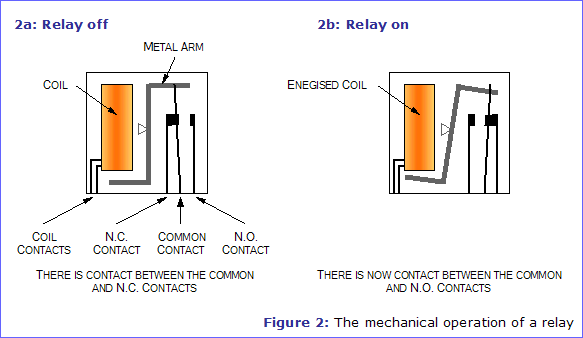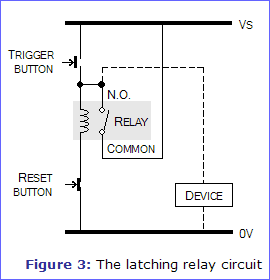
Relays
By Tim Surtell
It is often desirable or essential to isolate one circuit electrically from another, while still allowing the first circuit to control the second. For example, if you wanted to control a high-voltage circuit from your computer, you would probably not want to connect it directly to a low-voltage port on the back of your computer in case something went wrong and the mains electricity ended up destroying the expensive parts inside your computer.
One simple method of providing electrical isolation between two circuits is to place a relay between them, as shown in the circuit diagram of figure 1. A relay consists of a coil which may be energised by the low-voltage circuit and one or more sets of switch contacts which may be connected to the high-voltage circuit.

In figure 2a the relay is off. The metal arm is at its rest position and so there is contact between the Normally Closed (N.C.) switch contact and the 'common' switch contact.
If a current is passed through the coil, the resulting magnetic field attracts the metal arm and there is now contact between the Normally Open (N.O.) switch contact and the common switch contact, as shown in figure 2b.

Being mechanical though, relays do have some disadvantages over other methods of electrical isolation:
| Further Information | Diodes - Includes an example of using a protection diode with a relay |
When choosing a relay to use in a circuit, you need to bear in mind properties of both the coil and the switch contacts. Firstly, you will need to find a relay that has the required number of switch poles for your application. You then need to make sure that the switch contacts can cope with the voltage and current you intend to use - for example, if you were using the relay to switch a 60W mains lamp on and off, the switch contacts would need to be rated for at least 250mA at 240V AC (or whatever the mains voltage is in your country).
Also of importance is the material that the switch contacts are made of - gold is good for low-voltages, whereas tungsten is suitable for switching high voltages and currents.
Finally, you need to choose a relay that has a coil that can be energised by your low-voltage control circuit. Relay coils are generally rated by their voltage and resistance, so you can work out their current consumption using Ohm's Law. You will need to make sure that the circuit powering the coil can supply enough current, otherwise the relay will not operate properly.
| Further Information | Resistors - Includes a explanation of Ohm's Law |
If a relay is connected as shown in figure 3, it will become 'latched' on when the coil is energised by pressing the Trigger button. The only way to turn the relay off will then be to cut the power supply by pressing the Reset button (which must be a push-to-break type).

The technical name for this type of behaviour is 'bistable', since the circuit has two stable states for its output - on and off. Bistable circuits can also be constructed using many other components, including the 555 timer IC and transistors.
| Related Articles | The 555 Bistable Circuit |
What's the point of this circuit? The Normally Open switch contact of the relay could also be connected to a device such as a motor, as shown by the dotted connections in figure 3. The device will then run indefinitely until some event (maybe triggered by the device) momentarily presses the Reset button, thereby turning off the coil ready for the Trigger button to be pressed again.
This system could be used in a model which needs a 'Push to Operate' button. A motor and gearing system in the model can be used to press the Reset button to cut the power to the relay coil after the model has been running for a certain amount of time, or until a certain event has occurred. Of course, you would have to be sure that there was enough momentum in the mechanism that the button is released ready for the next cycle.
Article Information
Source: Electronics in Meccano - www.eleinmec.com
| First published in EiM: Issue 1 (September 1998)
Topic: Components Explained |
Created: 27/12/2002 |
Last modified: 02/11/2007
Top of Page | Homepage | About | Search | Topics | Features | Circuits Shop | yourEiM |
© 1998 - 2025 Tim Surtell |